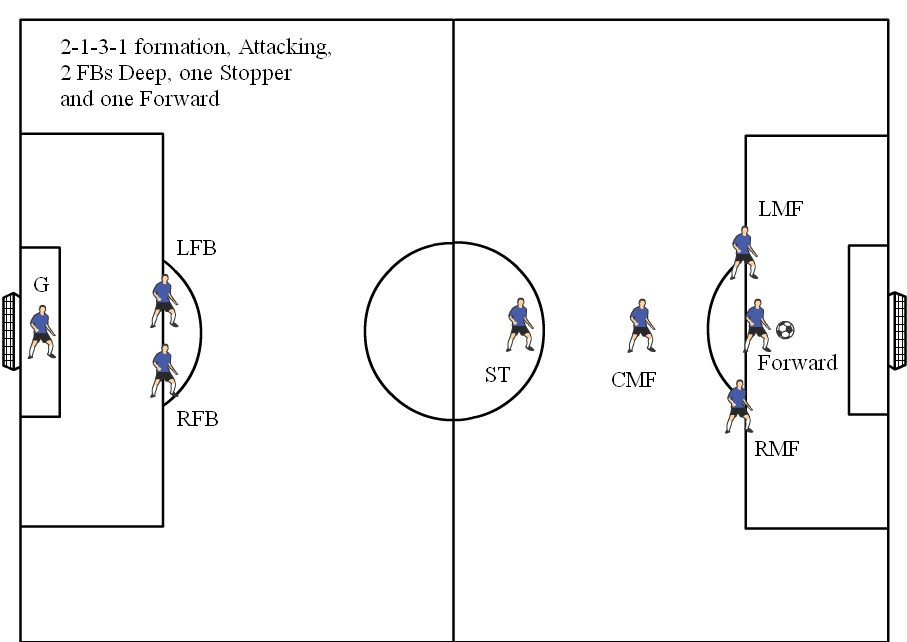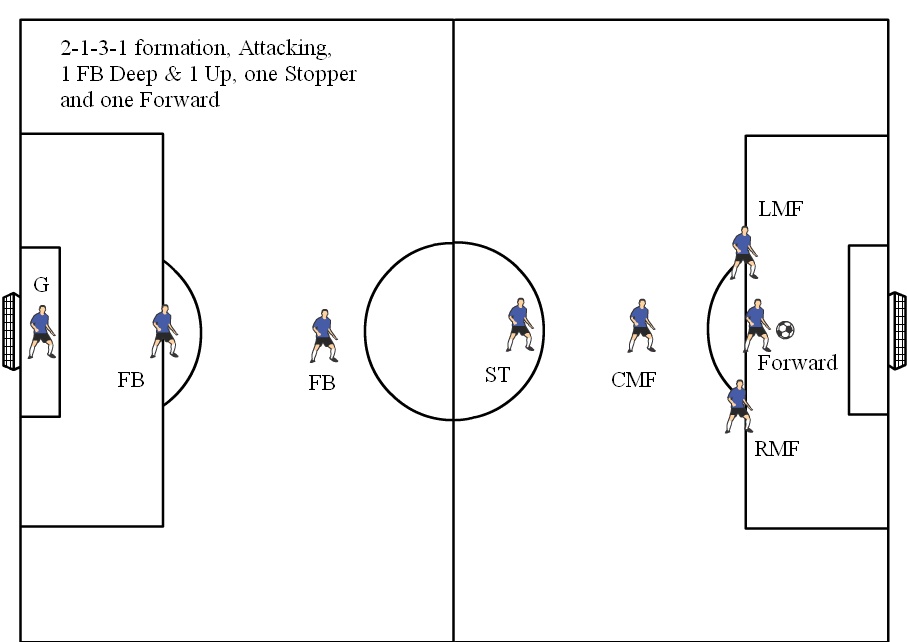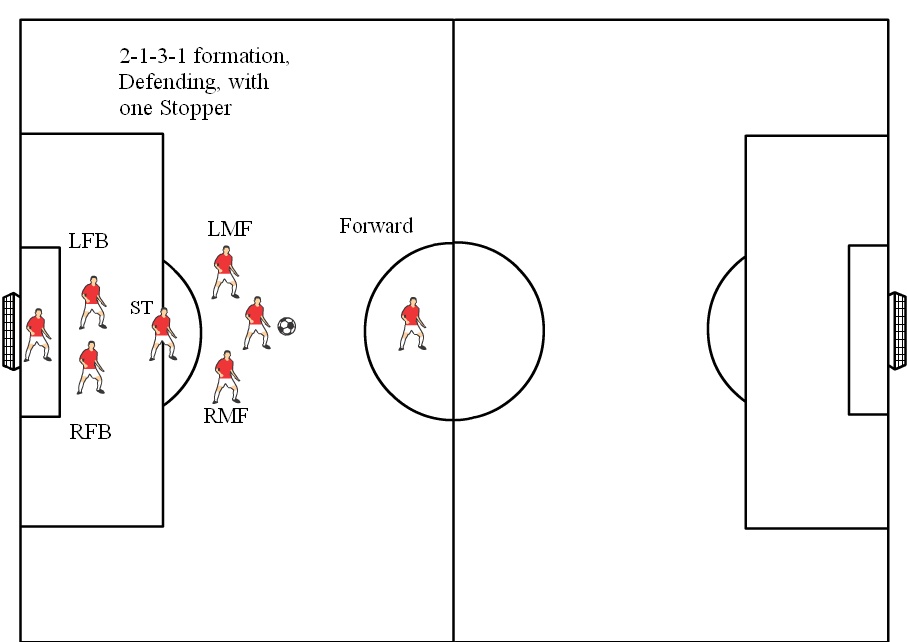Diagrams for 8v8 Soccer Formations
Attacking and Defending
Also see Diagrams of Soccer Formations & Soccer Positions Navigation Page
Below are diagrams of soccer positions for 8v8 soccer formations.
SoccerHelp Premium has 44 articles about 8v8 soccer formations such as 2-1-2-2, 2-1-3-1, 3-3-1, 2-3-2,1-2-2-2, 3-1-3 and 1-2-1-3 formations, and over 300 pages about soccer formations and how to teach soccer positions. The articles will help you choose the best formation for your Rec or Travel soccer team.
The soccer formation you choose can have a HUGE effect on your team's success and your formation and Style of Play are two of your most important decisions. If your team isn't doing as well as you would like, changing their soccer formation and Style of Play might make a difference.
It is impossible to have a Diagram that fits every team because the soccer formation you choose, the soccer positions you assign your players to, and the roles they will play on the field will be based on:
- The ability, speed and stamina of individual players
- The opponent you are playing
- Your Style of Play (do you Push Up on attack or Defend Deep, and to what extent you play a Possession Style/controlled passing style of play)
- The Number of subs you have
Keep in Mind that a Rec team CANNOT play like a Travel team because only some of the players on a Rec team are skilled whereas all the players on a Travel Team are skilled (there aren't any weak links on Travel Teams). It is better to be realistic than to try to get your team to do things they simply aren't capable of doing. I recommend you choose the soccer formation that works best for your team.
Also keep in mind that Defending Deep is better suited to Rec teams than to Travel teams.
A. Diagram Showing a 2-1-3-1 Soccer Formation with the Team Attacking and Both Fullbacks Defending Deep
The soccer positions diagram below shows a 2-1-3-1 formation with the team Attacking and both Fullbacks Defending Deep. A 2-1-3-1 soccer formation is a Goalie, 2 Fullbacks, 1 Stopper (who play like a Defensive Mid), 3 Midfielders and 1 Target Forward. This formations works well for many Rec Teams and there are many articles about it on SoccerHelp Premium. Advantages of this formation are that you have strength in the Center with a Center Mid and a Stopper and also that you have Right and Left Mid positions which are the best places for Rec coaches to put timid players (you can't put timid players at Fullback, but you can put slow and unskilled but brave players at Fullback). The Forward will need to be supported by a strong Center Mid. At the Stopper position, you need a brave player who ideally has speed, but he or she doesn't have to have good skills (a good, fast, aggressive athlete is a great choice). You will want to put a brave, skilled player at Center Mid, but this player doesn't have to be fast. This player will need to come into the attack to work with your Forward to score goals. You can put slow Players at Fullback as long as they Defend Deep and don't Push Up when you attack. The 2-1-3-1 soccer formation provides depth because it has 4 "rows" of players. It is a very good formation for many Rec teams and you won't give up goals on Breakaways if you use it and Defend Deep. (About whether to Push Up or Defend Deep -- Most Rec teams can safely Push Up until U10 because their opponents don't have a good attack. If your FB's are as fast as the opposing Forwards, you will probably want them to Push Up when you attack so they can support your attack, but if you Push Up slow FBs against a good team that has fast Forwards, you will give up lots of goals on Breakaways.)
The soccer positions diagram below shows your team on attack with the ball inside your opponent's Penalty Box. It shows the Fullbacks Defending Deep and the Stopper Pushed Up to the inside of the Center Circle to support the attack (when you teach positions, try to choose definite landmarks that young players can easily remember, like the halfway line, the Center Circle, the Penalty Box, the Goal Box and the Center of the Field which is an imaginary line between the 2 goals). The Forward is "onball". Notice the positioning of the Midfielders - they are a pass apart and shifted toward the ball to support the attack. KEEP IN MIND THAT in a real match, your Midfielders will need to keep moving to be in position to actually support the Onball Attacker. The Supporting Attackers are slightly behind the ball so not to be Offside and so they can run onto a Square Pass (Young players tend to get too forward and passes either go behind them or they can't get any power on a one-touch shot. By staying behind the ball the Supporting attackers have better visibility and can run onto the ball and one-touch shoot with the power coming from the run - they block the ball for accuracy instead of overkicking it). Notice that the Midfielders naturally form a triangle to support the Onball Forward - this occurs naturally - I recommend teaching your players First Attacker and Second Attacker instead of "triangles" because "triangles" aren't the objective, scoring is the objective. Notice how the Stopper is straight out from the ball in position to win a long cleared ball.

NOTE: The diagram above shows a 2-1-3-1 soccer formation with the team attacking (the ball is in the opponent's Penalty Box). It shows the Fullbacks Defending Deep. Read above about whether your team should Defend Deep or Push Up when you attack.
B. 2-1-3-1 Soccer Formation, Attacking, One Fullback Deep and One Pushed Up
The Diagram below is very similar to the one above except one Fullback has Pushed Up to the inside of the Center Circle. The Fullback you Push Up should be one who is brave and who has the speed to "Recover" to a defensive position when necessary and who can use good judgment about when to stand his ground and when to drop back. The Pushed Up Fullback's job when he is Pushed Up is to either break up the attack or at least slow it down so the Stopper has time to Recover to help defend. The point of this is that YOU SHOULD DO WHAT GIVES YOUR TEAM THE BEST CHANCE FOR SUCCESS. Pushing Up is great if your team can do it, but it is a bad idea if it causes you to give up lots of goals on Breakaways. There are many variations of Pushing Up. If your Fullbacks are as fast as the opposing Forwards and if they can "Recover" to defensive positions, then you can Push Up your Fullbacks. But if your Fullbacks are slow or can't remember to "Recover" quickly when your team loses the ball, then there is a risk that your opponent launches a fast counterattack and you don't have any fullbacks in position to defend your goal, so it could be several attackers against your Goalie. Read "A" above for more explanation. When you teach positions, try to choose definite landmarks that young players can easily remember, like the halfway line, the Center Circle, the Penalty Box, the Goal Box and the Center of the Field which is an imaginary line between the 2 goals.

NOTE: The diagram above shows a 3-2-3-2 soccer formation with the team attacking (the ball is in the opponent's Penalty Box). It shows one Fullback Pushed Up. Think about whether your team should Defend Deep or Push Up when you attack.
C. 2-1-3-1 Soccer Formation with the Team Defending In Their Defensive Third
The diagram below shows a shows a 2-1-3-1 formation with the team defending in their Defensive Third. NOTE: This diagram shows the ball in the Center (straight out from the goal). As the ball moves, your players MUST move to stay between the ball and the goal AND to provide pressure on the ball, support for the First Defender, and defensive coverage of the area between the ball and the goal. I think the best way to teach this is by teaching First Defender, Second Defender and Shifting and Sagging. The most critical area to defend is the area in front of the goal - that is where most goals are scored at all levels of play. Even at the highest levels of play, a Packed In Defense is hard to score against. NOTE that when your team defends your goal, it is CRITICAL that you leave at least one Forward Pushed Up a long kick from the ball. That is necessary so you can clear the ball away from your goal and it will also keep 2 or 3 of the opposing Fullbacks from coming onto your half of the field because they will be afraid of over-the-top long balls that could result in Breakaways. You must leave at least one Forward Pushed Up even if your defense is Packed In. The Diagram below shows the Forward positioned a long kick out from the ball and in position to win cleared balls that are kicked straight ahead (I recommend Rec teams clear the ball by kicking it straight ahead so the Forwards can shift with the ball and be in position to win cleared balls). Note that on Rec teams the Forwards should shift with the ball, side-to-side and up and back, staying straight out from the ball and a long kick away from the ball, BUT they can't cross the Halfway Line unless there is a defender closer to the opponent's goal or they could be called offside. This diagram is more applicable to Rec teams than to Travel teams - Rec teams can pack the defense in tight and are mostly concerned about the Goal Front but Travel teams will have to defend more width because their opponents can use the field width to score.

NOTE: The diagram above shows a 2-1-3-1 soccer formation with the team Defending inside its Defensive Third. As the ball moves, your players MUST move to stay between the ball and the goal AND to provide pressure, support and defensive coverage of the area between the ball and the goal. I think the best way to teach this is by teaching First Defender, Second Defender and Shifting and Sagging
D. More Articles About Soccer Formations & Soccer Positions:
Soccer Formation Basics (How to choose a soccer formation)
How to Select a Soccer Formation and Assign Positions - Tips for selecting a formation and assigning positions.
The 2-1-2-2 Formation, the importance of a Stopper and Assigning Positions
Soccer Positions Basics & Soccer Kick-Offs
Youth Soccer Positions - How to Teach, Coach & Assign
How to Choose a Soccer Formation 22 questions to help you choose the best soccer formation
How to Assign Soccer Positions 25 tips for assigning soccer positions